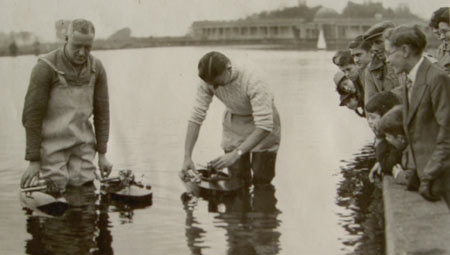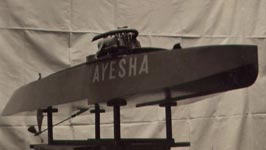

|
Home Updates Hydros Cars Engines Contacts Links King's Lynn I II III Contact On The Wire |
They Do Different In Norfolk

It is a well known saying in this neck of the woods that 'they do different in Norfolk' and this 70-year-old photograph introduces a series of articles illustrating just how true this was in relation to the select membership of the King's Lynn Club. On the left of the picture taken at Eaton Park Norwich around 1937, is John Duffield, with ‘Lyn I’ and Bert Stalham’s ‘THA’ and in the centre, George Chapman with ‘Bobsie III'.
Both the motor in ‘Lyn’ and the later supercharged engine that John Duffield built have survived, but what was not appreciated at first, was that George Chapman was also responsible for building the last of John’s boats. Even better was the news that George was still taking an active interest at the grand age of 96 years old. Thanks to George’s son Trevor, who has supplied us with a series of superb photographs, and a great deal of personal information, OTW is pleased to be able to complete the story of the King’s Lynn stalwarts and the superb engineering that emanated from North Norfolk.
Each of the tethered hydroplane enthusiasts from the King's Lynn Club claimed that because of their geographic location so far removed from the centres of hydroplane racing, they were ploughing ‘a lonely furrow’. It is appropriate therefore, that the last article celebrating 100 years of tethered hydroplane racing should pay tribute to our most senior competitor, George Chapman, and through him, the amazing engines and boats produced by the ‘lone hands’ of King's Lynn, ploughing their collective ‘lone furrows’.
Lone hand 1: George Chapman
|
|
The ‘youngster’ of the group was George Chapman, born in 1912. He appeared alongside Bert Stalham and John Duffield at regattas from 1937 until ‘old age’ and ill health broke up the King's Lynn Club around 1960 and he really did find himself a ‘lone hand’. With nowhere local to run and no one to help him, George had little option but to retire from the sport, but in the 25 or so years he was involved he had made quite a mark. |
George probably became acquainted with Bert Stalham when Bert, who was an electrical engineer, installed power in the Chapman family home. Although George had been apprenticed as a carpenter and was working for building firms, he was interested in all things mechanical and started to go and watch Bert flying his model planes. He quickly became involved, flying his own plane with an engine that Bert had given him, possibly a Stuart. Within a couple of years, George had turned his attention to tethered hydroplanes, and as they shared interests, Bert soon joined him in this new modelling pursuit.
|
|
Photos from 1936/7 show George with ‘Bobsie III’, a conventional single step hydro, fitted with a 15cc single cylinder four-stroke engine. George’s fiancée Joyce was nicknamed Bob, hence ‘Bobsie’ for the boats, but that begs the question as to whether there was a Bobsie I or II that appeared even earlier? |
There was also a boat called ‘Ayesha’, which looks a very early design, although the motor may have been transferred to the other boats. The engine is unusual in having the carburettor and exhaust fore and aft, mounted conventionally in 'Ayesha' but reversed in 'Bobsie'. The origins of 'Ayesha' and the motors are a mystery at present although George recalls naming the boat after the main character in King Solomon's Mines. |
 |
With the outbreak of war, building work stopped almost overnight and George became a grinder at Cooper Roller Bearings in King's Lynn, returning in 1945 to building with local companies as a carpenter and foreman. With hydroplane racing suspended for the duration, there had been little development with boats and engines, but this was to change very quickly, especially in King's Lynn.
|
With Dr Hewlett, John Duffield and Bert Stalham working on very complex supercharged engines, George Chapman started work on his own ‘masterpiece’ but took a quite different design route to the others. He avoided the complications of superchargers or multiple cylinders, sticking with conventional rear rotary induction. With a real understanding of an appropriate present, George’s wife gave him a large block of Dural for Christmas as the first step towards the construction of another remarkable motor. The finished engine made its debut at the 1952 Model Engineering Exhibition. |
|
The most obvious feature of the engine, and one that caused much comment, was the four silencers, arranged in pairs either side of the cylinder. In his report, Edgar Westbury comments on the ‘painstaking work’ but then criticises the level of cleaning and polishing that had been done. He also questioned the wisdom of the four exhausts, not realising that these were a carefully considered part of the design. George was asked about this on several occasions and maintained that they were ‘tuned pipes’ that were being talked about at that time, and anyway, it went better with four than with two, so they were ‘tuned’! Another feature, common to other King's Lynn engines was that the cylinder and head were square.
|
15cc Racing Hydroplane Class B G J Chapman, King's Lynn ME Soc Complete weight 8½lbs Engine: Two-stroke 15cc capacity 1⅛" bore ⅞" stroke Rotary valve crankcase admission Engine timing: Admission 175° Transfer 80° Exhaust 100° Speed in water at 15,000rpm 55.5mph |
|
|
George recalls that he had managed to obtain some very thin plywood from a local wood yard that had been the packing for other timber products. Using some of this ply, he put his boat building skills to work to produce a very attractive and light hull with integral sponsons that was christened ‘Wishbone’.
|
|
|
Like many other boats, the engine is mounted on plates that bolt through the sides of the hull to make a very strong structure. With the hull skins pinned and glued and a hardwood trim along the deck line, the varnished finish shows the true quality of the construction to the very best advantage. ‘Wishbone’ and Duffield's ‘Lyn III’ are very similar in shape, although there are noticeable differences between the two boats. The most obvious being that George’s boat has a substantial skeg mounted on the transom, putting the prop well behind the boat, while ‘Lyn’ has the skeg underneath the hull.
|
The relative simplicity of his engine design compared with the others was to pay dividends, with ‘Wishbone’ by far the most successful of the post war King's Lynn boats, featuring regularly in regatta results from around the country. At the MPBA regatta in 1954 ‘Wishbone’ finished 3rd in the Miniature Speed Championship and 3rd again at the final event at Blackheath with a run at 40.1 mph. It was very competitive in the ‘B’ class and could give several of the 30cc boats a run for their money. In the finishing order at the 1956 International, Bill Everitt’s 30cc ‘Melody’ recorded 56.9 mph, ‘Wishbone’ 55.55 mph and Jim Bamford’s 15cc ‘JAB III’ 55.53 mph. |
|
|
|
Model Engineer reports a misfortune that befell ‘Wishbone’ at the 1956 King's Lynn regatta, when the starting cord became entangled with the flywheel as the engine started and smashed a hole in the bottom of the boat. Far from being the end of the regatta for George, the hole was quickly repaired with ‘a motor tyre patch’ and ‘Wishbone’ went on to complete the meeting. Model Engineer for 18th July 1957 featured regatta reports from the Forest Gate event at Victoria and Longholme Lake Bedford. The cover photo featured George starting ‘Wishbone’ on the bank at Bedford with Frank Jutton’s ‘NIKE’ and Colin Stanworth’s 'Whizz 2' either side and John Skingley at Victoria with one of the later ‘Sparky’ boats. The onlooker is Leonard Petts, a relation of Bert Stalham who accompanied him to regattas. Oddly, this was one occasion though where ‘Wishbone’ did not appear on the results list. |
|
By the late 50s, 10cc commercial engines were tending to dominate events, both in terms of outright speed and numbers of competitors, but happily there were still a number of enthusiasts like George Chapman who avoided this approach for whatever reason, and continued to run engines that they had designed and built. Their numbers were dwindling though and tethered hydroplane racing would never again see the diversity of design and engineering riches that the likes of the King's Lynn group and others produced. George retired from racing when the rest of the group ‘faded away’, but continued to visit regattas for several years. He retained ‘Wishbone’, which stands alongside John Duffield's ‘Lyn III’ as surviving examples of his superb boat building skills. The rubber patch used to repair the boat in 1956 is still in place. |
|
|
|
George died in January 2010 aged 97. Happily he remained active to the end of his life and it was a great pleasure for OTW to have visited him to photograph 'Wishbone' and Bert Stalham's boat and engine. His input into the story of the King's Lynn group told on these pages has been invaluable as were the many photographs he and his son Trevor provided for these articles. 'Lyn 3' with 'Wishbone' and newly built 'Lyn 4' |
As a postscript, Trevor very kindly allowed the 'Wishbone' to be exhibited on the Model Hydroplane Club stand at the 2013 ME Exhibition at Alexandra Palace some sixty years after the engine had first appeared at the Royal Horticultural Halls.
©copyrightOTW2016